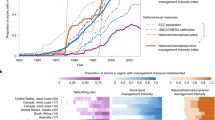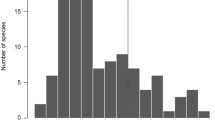Abstract
The only available data set on the catches of global fisheries are the official landings reported annually by the Food and Agriculture Organization of the United Nations (FAO). Attempts to detect and interpret trends in these data have been criticized as being both technically and conceptually flawed. Here, we explore and refute these claims. We show explicitly that trends in catch data are not an artifact of the applied method and are consistent with trends in biomass data of fully assessed stocks. We also show that, while comprehensive stock assessments are the preferred method for evaluating single stocks, they are a biased subsample of the stocks in a given area, strongly underestimating the percentage of collapsed stocks. We concur with a recent assessment-based analysis by FAO that the increasing trends in the percentage of overexploited, depleted, and recovering stocks and the decreasing trends in underexploited and moderately exploited stocks give cause for concern. We show that these trends are much more pronounced if all available data are considered.








Similar content being viewed by others
References
Beverton RJH, Holt SJ (1957) On the dynamics of exploited fish populations. In: Fishery investigations, Series II, 19. Her Majesty’s Stationery Office, London, p 533
Branch TA, Jensen OP, Ricard D, Ye Y, Hilborn R (2011) Contrasting global trends in marine fishery status obtained from catches and from stock assessments. Conserv Biol. doi:10.1111/j.1523-1739.2011.01687.x
Burkus D (2011) The portable guide to leading organizations. LeaderLab Press
Carruthers TR, Walters CJ, McAllister MK (2012) Evaluating methods that classify fisheries stock status using only catch data. Fish Res 119–120:66–79
Daan N, Gislason H, Pope JG, Rice JC (2011) Apocalypse in world fisheries? The reports of their death are greatly exaggerated. ICES J Marine Sci. doi:10.1093/icesjms/fsr069
EC (2009) Green Paper: reform of the common fisheries policy. EC, Brussels, Com 163. Retrieved from http://ec.europa.eu/fisheries/reform/ in Jan 2010
FAO (2009) Guidelines for the ecolabelling of fish and fishery products from marine capture fisheries, revision 1. FAO, Rome, 97 pp. Downloaded on 14 Dec 2011 from http://www.fao.org/docrep/012/i1119t/i1119t.pdf
FAO (2010) The state of world fisheries and aquaculture 2010. FAO, Rome
Froese R (2011) Fishery reform slips through the net. Nature 475:7
Froese R, Kesner-Reyes K (2002) Impact of fishing on the abundance of marine species. ICES Document CM 2002/L:12, 15 pp
Froese R, Kesner-Reyes K (2009) Out of new stocks in 2020: a comment on “Not all fisheries will be collapsed in 2048”. Marine Policy 33:180–181
Froese R, Pauly D (2003) Dynamik der Überfischung. In: Warnsignale aus Nordsee und Wattenmeer—eine aktuelle Umweltbilanz. GEO, Hamburg, pp 288–295
Froese R, Proelß A (2010) Rebuilding fish stocks no later than 2015: will Europe meet the deadline? Fish Fish 11:194–202
Froese R, Branch TA, Proelß A, Quaas M, Sainsbury K, Zimmermann C (2011) Generic harvest control rules for European fisheries. Fish Fish 12:340–351
Garcia SM, de Leiva Moreno I, Grainger R (2005) Global trends in the state of Marine fisheries resources 1974–2004. In: Review of the state of world marine fishery resources. FAO Fisheries Technical Paper. No. 457. FAO, Rome, 235 pp
Garibaldi L (2012) The FAO global capture production database: a six-decade effort to catch the trend. Marine Policy 36:760–768
Grainger RJR, Garcia SM (1996) Chronicles of marine fishery landings (1950–1994): trend analysis and fisheries potential. FAO Fisheries Technical Paper No. 359, 51 pp
Kleisner K, Pauly D (2011) Stock-catch status plots of fisheries for Regional Seas. In: The state of biodiversity and fisheries in Regional Seas. Fish Centre Res Rep 19(3):37–40
Pauly D, Alder J, Booth S, Cheung WWL, Christensen V, Close C, Sumaila UR, Swartz W, Tavakolie A, Watson R, Wood L, Zeller D (2008) Fisheries in large marine ecosystems: descriptions and diagnoses. In: The UNEP Large Marine Ecosystem Report: a Perspective on Changing Conditions in LMEs of the World’s Regional Seas. UNEP Regional Seas Reports and Studies No. 182, pp 23–40
Saila S, Roedel P (eds) (1980) Stock Assessment for Tropical Small-Scale Fisheries. Proc. Intern. Workshop, Sept. 19–21 (1979). Univ. Rhode Island. Intern. Center Mar. Res. Development
Schaefer MB (1954) Some aspects of the dynamics of the population important to the management of the commercial marine fisheries. Inter Am Trop Tuna Comm Bull 1:25–56
Srinivasan UT, Cheung WWL, Watson R, Sumaila UR (2010) Food security implications of global marine catch losses due to overfishing. J Bioecon 12(3):183–200
Wald A (1943) A method of estimating plane vulnerability based on damage of survivors. Statistical Research Group, Columbia University. CRC 432—reprint from July 1980 (http://cna.org/sites/default/files/research/0204320000.pdf). Center for Naval Analyses
Wilberg MJ, Miller TJ (2007) Comment on “Impacts of biodiversity loss on ocean ecosystem services”. Science 316:1285
Worm B, Barbier EB, Beaumont N, Duffy JE, Folke C, Halpern BS, Jackson JBC et al (2006) Impacts of biodiversity loss on ocean ecosystem services. Science 314:787–790
Worm B, Barbier EB, Beaumont N, Duffy JE, Folke C, Halpern BS, Jackson JBC et al (2007) Response to comments on “Impacts of biodiversity loss on ocean ecosystem services”. Science 316:1285
Worm B, Hilborn R, Baum JK, Branch TA, Collie JS, Costello C, Fogarty MJ et al (2009) Rebuilding global fisheries. Science 325:578–585
Zeller D, Cheung W, Close C, Pauly D (2009). Trends in global marine fisheries-a critical view. In: Fisheries, trade and development. Royal Swedish Academy of Agriculture and Forestry, Stockholm, pp 87–107
Acknowledgments
We thank the numerous reviewers for forcing us to back up our points with data. We thank the editors of Marine Biology for publishing this study, which evolved from two short responses into quite an elaborate document. Rainer Froese wishes to thank the Future Ocean Excellence Cluster 80, funded by the German Research Foundation on behalf of the German Federal State and State Governments. Daniel Pauly, Kristin Kleisner, and Dirk Zeller acknowledge support from the Sea Around Us Project, a collaboration between the University of British Columbia and the Pew Environment Group. We thank Boris Worm for comments on an early version of this manuscript.
Author information
Authors and Affiliations
Corresponding author
Additional information
Communicated by U. Sommer.
Rights and permissions
About this article
Cite this article
Froese, R., Zeller, D., Kleisner, K. et al. What catch data can tell us about the status of global fisheries. Mar Biol 159, 1283–1292 (2012). https://doi.org/10.1007/s00227-012-1909-6
Received:
Accepted:
Published:
Issue Date:
DOI: https://doi.org/10.1007/s00227-012-1909-6




